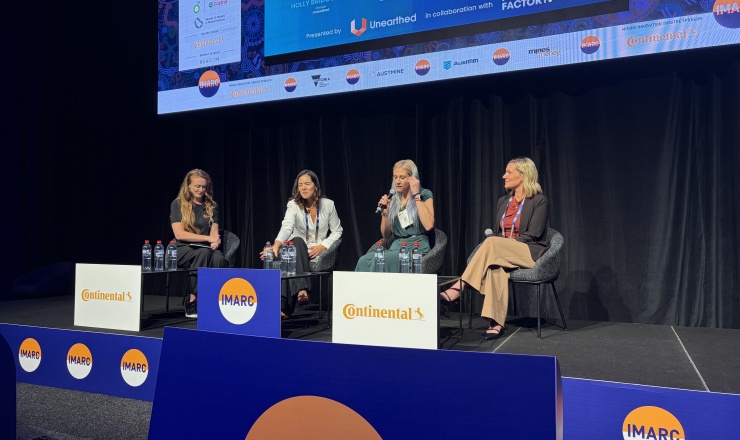
Funding the Future of Mining Tech at IMARC 2025
Hosted by Unearthed in collaboration with Founders Factory , our session “Funding the Future of Mining Tech” brought together a
Read articleThe Unearthed Melbourne Hackathon marked the last national event of a successful 2015 for Unearthed. The 54-hour resource sector open innovation event, part of the broader International Mining and Resources Conference, focused on the emerging Internet of Things (IoT). Operational, process and safety challenges were opened for the development of new and exciting hardware and sensor prototypes.
43 participants and 12 submissions later, combined CSIRO and RMIT team ‘PPE of Things’ (Prem Jayaraman, Jonathan Liono, Ali Yavari, Philip Valencia, Andrew Hellicar, Karl Von Richter and Ahmad El Shoghri) walked away triumphant with first prize of $2,500 and $3,000 AWS credits.
The team addressed two real-world challenges simultaneously – The Smart Phone of Things supplied by Anglo American, and 'How can we improve safety in the workplace with wearable devices?' by Newcrest. The PPE of Things prototype involved employing low cost Bluetooth sensing technologies to inform mine staff of potential safety hazards.
Unearthed sat down with Prem Jayaraman to find out more about the team’s hackathon experience.
Q. Could you provide a quick description of the approach that you took and your prototype?
A. We developed a prototype called the ‘PPE of Things’ – the personal protective equipment of things. We ended up using cheap sensors and we put the sensors on all the personal protective equipment: safety glasses, helmets and even boots. We were able to detect things like hazardous actions, compliance issues such as someone not wearing their glasses in the right position.
The smart thing that we did was that because we had sensors on multiple equipment, we could distinguish someone just looking up as opposed to the glasses not being worn correctly and probably being inclined on the helmet.[pullquote type="left"]We were able to detect things like hazardous actions, compliance issues such as someone not wearing their glasses in the right position.[/pullquote]
Being able to distinguish those kinds of errors was key. Any non-compliance detected – such as not wearing the glasses or even ‘man down’ (if somebody falls over) would be reported back to the user to see if the person is still responding. If there is no response within a given time, alerts are sent across the hierarchy such as to a manager and nearest first aider.
Q. In one sentence, could you describe the backgrounds of each group member?
A. We are team with expertise in Internet of Things, machine learning and data analytics and are combination of researchers and students. Phil Valencia, Andrew Hellicar, Karl von Richter and Ahmad El Shoghri are from CSIRO. I am a Research Fellow at RMIT and Jonathan Liono and Ali Yavari are PhD candidates from RMIT University.
Q. How did you meet? Do you all work together?
A. Yes we do. I was previously working at CSIRO just before starting work at RMIT. I would like to thank Arkady Zaslavsky, a principal research scientist at CSIRO, for getting us all together. I would also like to thank Prof. Dimitrios Georgakopoulos from RMIT for his support.
Q. Describe your experience working in the resource space. Did you encounter any challenges?
A. It was very exciting. CSIRO does a lot of work in this sector and through them I’ve been involved in some [resource sector] projects so I’ve had some previous experience. From an Internet of Things perspective, it was very interesting and also quite challenging to apply existing technology in the real world. One of the things we did well during the hackathon was having some sort of business solution that had a clear value to the user.
Q. What impact could your prototype hold for the industry? Do other industries use this current approach? To what outcomes?
A. Health and safety is a major issue in any industry, particularly in mining. Our approach looks to how we can improve workers’ safety in hazardous environments – that’s where our prototype could be most useful. We can’t claim that we can save lives but that’s where our intention lies – protecting people, improving levels of safety and creating a much better proactive [protective] system using technology.[pullquote type="right"]We can’t claim that we can save lives but that’s where our intention lies – protecting people, improving levels of safety and creating a much better proactive [protective] system using technology.[/pullquote]
Q. What do you see as the potential future of your prototype?
A. We’ve received good interest from the industry, particularly from Anglo [American], so we are currently in discussions to see if we can convert this into a product. We’re still exploring opportunities with our organisations and with Unearthed.
Q. Finally, what tips can you give to future participants at Unearthed Hackathons?
A. The key is to come up with a clear business idea. A lot of people in technology hackathons come in with the mindset that they need to show a lot of technology in the hackathon, but you need to focus on showing the value that comes out of it. Technology today is so fast and could be used for lot of things but whether or not it adds value is the biggest question – and what any developer in a hackathon needs to highlight.